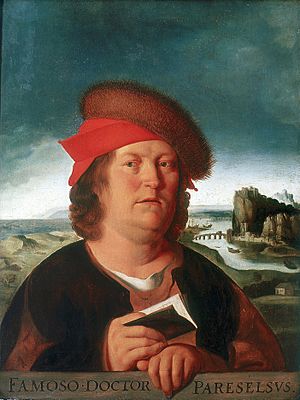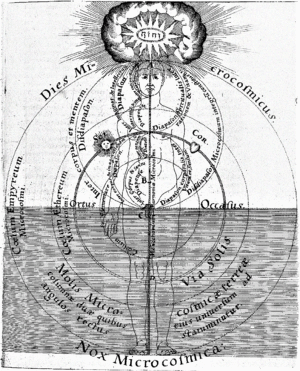Microcosm–macrocosm analogy facts for kids
The microcosm-macrocosm analogy is an old idea that says humans are like a small version of the entire universe. It suggests that what is true for the huge universe (the macrocosm) is also true for a human being (the microcosm).
The words microcosm and macrocosm come from ancient Greek. Microcosm means 'small universe'. Macrocosm means 'great universe'. This idea suggests that humans and the universe share similar structures and rules.
Many ancient thinkers believed the universe was alive and had a "world soul." This idea was shared by famous philosophers like Plato. If the universe had a divine soul, then human souls were also seen as divine.
This analogy was also used to explain the human body. For example, the functions of the seven classical planets were sometimes compared to the functions of human organs. The heart, spleen, and liver were thought to be connected to different planets.
This view is very old and can be found in many cultures around the world. It appeared in ancient Mesopotamia, ancient Iran, and Chinese philosophy. However, the terms microcosm and macrocosm are mostly used for the ideas developed in ancient Greek philosophy and later periods.
Today, these terms can also describe any small system that represents a larger one, and vice versa.
Contents
History of the Microcosm-Macrocosm Idea

Ancient Times
Many ancient Greek and Hellenistic thinkers believed in the microcosm–macrocosm idea. These included Anaximander (around 610–546 BCE) and Plato (around 428 or 424–348 BCE). Doctors like the Hippocratic authors (from the late 5th century BCE) also used this idea. The Stoics (from the 3rd century BCE) also supported it.
Later, philosophers like Philo of Alexandria (around 20 BCE–50 CE) and the Neoplatonists (from the 3rd century CE) used this idea often. It was also found in religious writings from later ancient times. Examples include the Bundahishn, a Zoroastrian book, and the Avot de-Rabbi Nathan, a Jewish text.
Middle Ages
During the Middle Ages, the ideas of Aristotle were very popular. Even though Aristotle had first used the word "microcosm," he believed there was a big difference between Earth and the heavens. Still, the microcosm–macrocosm idea was used by many thinkers.
This idea was known in Arabic as ʿālam ṣaghīr, in Hebrew as olam katan, and in Latin as microcosmus. It was explored by alchemists and by a group of Shi'ite philosophers called the Ikhwān al-Ṣafāʾ. Jewish thinkers like Isaac Israeli (around 832–932) and Judah Halevi (around 1075–1141) also wrote about it. Other important figures included Ibn Arabi (1165–1240) and Nicholas of Cusa (1401–1464).

Renaissance Period
The Renaissance saw a renewed interest in ancient ideas like Hermeticism and Neoplatonism. These philosophies strongly featured the microcosm–macrocosm analogy, making it very popular again.
Key supporters of this idea during the Renaissance included Marsilio Ficino (1433–1499) and Giordano Bruno (1548–1600). It was also central to the new medical theories of the Swiss physician Paracelsus (1494–1541) and his followers, especially Robert Fludd (1574–1637). The anatomist Andreas Vesalius (1514–1564) also noted that the human body "matches the universe wonderfully."
Microcosm-Macrocosm in Judaism
 In Spanish: Microcosmos y macrocosmos para niños
In Spanish: Microcosmos y macrocosmos para niños
The idea of a link between the human being (microcosm) and the universe (macrocosm) is found throughout Jewish philosophy. It suggests that humans are a "small universe" (Olam katan in Hebrew).
The Jewish philosopher Philo of Alexandria (around 20 BCE–50 CE) used this idea. Similar thoughts also appear in early Rabbinical literature. In the Middle Ages, this analogy became a major theme for most Jewish philosophers.
Rabbinical Writings
In the Avot de-Rabbi Nathan (written around 700–900 CE), parts of the human body are compared to parts of the larger world. For example, hair is like a forest, lungs are like the wind, and the stomach is like a mill.
Jewish Philosophy in the Middle Ages
The microcosm–macrocosm analogy was common among medieval Jewish philosophers. They were often influenced by Arabic philosophers. A very important work was the Epistles of the Brethren of Purity, written in the 10th century by a group of Shi'ite philosophers. This book greatly influenced Jewish thinkers in Islamic Spain.
Earlier Jewish philosophers also used this idea. Saadia Gaon (882/892–942) compared the cosmos, the Tabernacle, and the human being in his writings. Later authors like Bahya ibn Paquda and Abraham ibn Ezra followed his lead.
While earlier Rabbinical writings had simple comparisons, later philosophers like Bahya ibn Paquda and Joseph ibn Tzaddik (in his book Sefer ha-Olam ha-Katan, "Book of the Microcosm") gave more detailed comparisons. They linked human body parts to heavenly bodies and other parts of the universe.
The idea of "know thyself" (gnōthi seauton in Greek) was connected to this analogy by Isaac Israeli (around 832–932). He believed that by understanding oneself, a person could understand everything. Joseph ibn Tzaddik added that this self-knowledge could even lead to knowing God. Judah Halevi saw God as the spirit and life that gives the universe its energy. Maimonides (1138–1204) thought the relationship between God and the universe was like the relationship between the mind and a human being.
See also
- As above, so below
- Correspondence
- Great chain of being
- Hermeticism
- Panpsychism
- Paracelsus and microcosm-macrocosm
- Plato's Timaeus
- Robert Fludd and microcosm–macrocosm
- Stoic cosmology and psychology
- World soul


